HID Information
#1
Disclaimer: This is an educational post about HIDs. What I have written is merely to help assist your research. What you do to your vehicle is solely your own resposibility and I am not liable for any mistakes that you do. By reading this, you have acknowledged the above statement. Enjoy 
with so many HID posts in the past few weeks, I thought I create this post to help educate people.
So you want HIDs?
Ok, so now where to start? First thing first. Lets learn about HIDs systems and how to select the proper one. There are so many options out there what do all the options all mean?! 4300K? 6000K? 10000K? What are these K numbers? Color of the light output is measured on a kelvin scale.
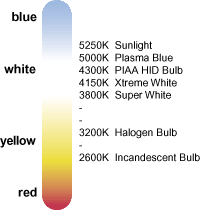
The above picture shows how certain PIAA bulbs match in terms of color.
Factory equpped vehicles use 4300K HID bulbs. This is the closest to white light. Note: the closely the number gets to blue, the less lumens the bulbs will output. So what is the output measured in?
All light output is measured in a unit called Lumens. One lumen is equivalent to one foot candle falling on one square foot area. This is a rather small amount of output. Typical halogen headlights output nowadays range from 1500-2000lumens average. This is where HIDs shine! An OEM hid bulb with the color 4300k will emit about 3200 lumens. This is almost 50% more light! Keep in mind, as the bulb reaches higher in the Kelvin temperature scale, the output reduces. This is because we are reaching the end of our visible light spectrum.
The most optimal color output is 4300K-5300K temperature. This seems to be the best of compromise of white light and output. I recommend this temperature.
Here's a picture of the different temperatures of HID's
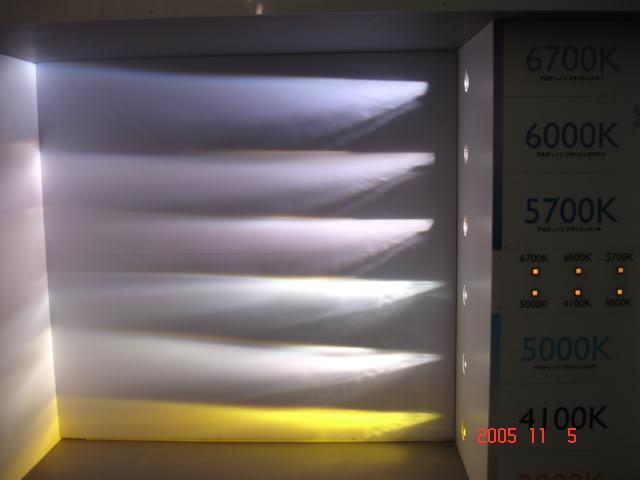
Okay, now that we gone thru the output and colors, lets go over the system itself.
There are basically three main components to a HID system.
-Ballast
-Bulb
-Wiring
Ballast - This is the main component that creates the huge 23,000 volts to ignite the bulb. This is the main component to the HID system. It starts up the bulb and maintains its charge. On older sytems an igniter was external but new current sytems have the igniter inside the ballast. This igniter is similar to a spark plug to create the current in the HID bulb.
Bulb - The bulb needs no real introduction except that it behaves differently than a typical halogen bulb. Instead of heating up a wire in a sealed gas to create output, the HID bulb is filled with just gas. The HID bulb is similar construction like a fluorescent bulb. Current is driven through the tube and it creates an arc of light when the gas is charged. This is as simple of an explaination as I can get. I won't get into details as this is not HOW HID WORKS post. There are two types of HID bulbs: D2R and D2S. D2R is for reflective housings and D2S is for projector type housings. D2R has painted ceramic coating on the bulb to help aid with glare. It also has a different bulb base but can be modify to fit D2S housings with a dremel.

D2R above
D2S below

Wiring - This is simple task to give power to the ballast and needs no true introduction.
Now new systems have a special feature called Bi-Xenon. This is where a solenoid powered flap opens up when the high beams are switched on. this flap allows extra light that was blocked to show the upper region of your visibility. This is a new feature that many love since you get HID on your high beams as well. VERY beneficial on dark roads in the middle of nowhere.
What about all these plug n play kits on ebay or honda-tech?
-I highly do not reccomend these kits. why? I'll explain once I get into more about OEM HID systems.
Under DOT and ECE rules for lighting, lights coming from a car should not have alot of glare so that oncoming drivers are not blinded by the light. If there was no regulation, chances are the oncoming driver can hit you on an unprotected 2way road due to being blinded by these HID since these bulbs are 50% brighter than stock halogens.
DOT and ECE and JDM regulations have developed specific cutoffs to help aid with this sitation. There is more light on the passenger side to help aid reading overhead signs. RHD should output more on the left side and LHD should have more output on the right side. Below is a pic to show the cutoff.
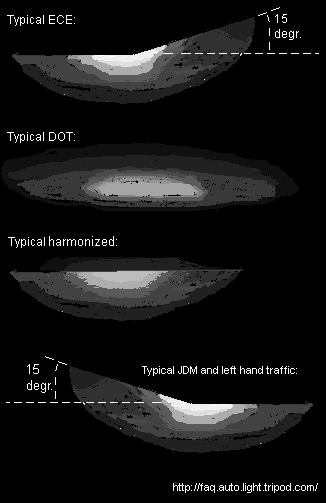
As you can see, this helps so that oncoming drivers will not be blinded by your insanely bright HIDs. So now you understand what HID systems should do, i can explain why plug n play kits sux0rs.
Halogen reflector housings and projector housings were not designed to accomdate the way HID bulbs reflect. HID bulbs do not act the same way as halogen and using halogen development reflectors and projectors will cause unwanted glare.
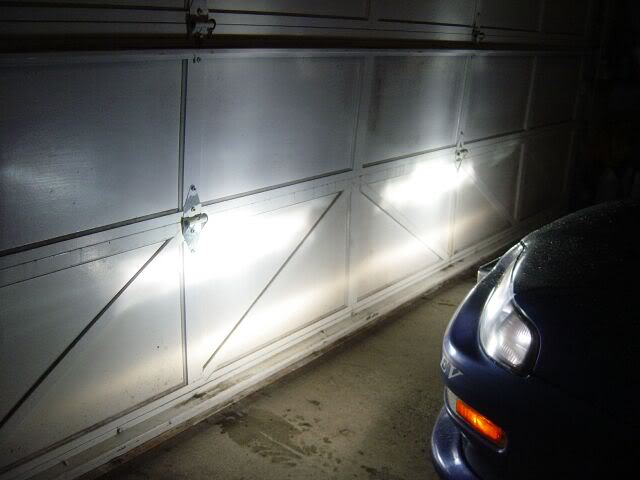
as you can see above, the housings do not accomdate the extra light and just shoots it everywhere. This will indeed blind oncoming drivers as well as drivers in front of you.
This is how it should look like from a retrofit.
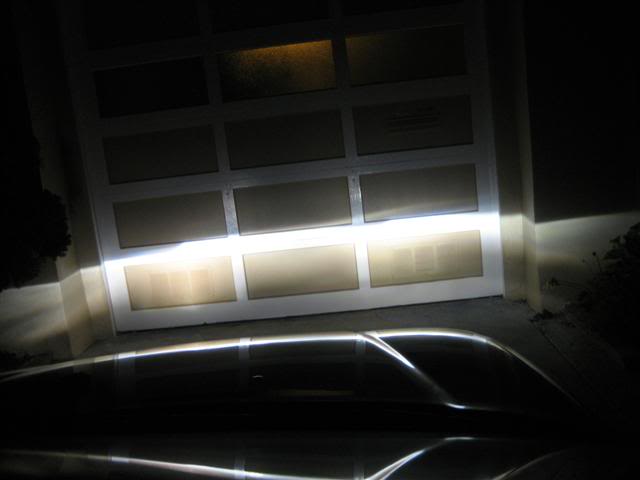
This my own personal setup and as you can see, the upper light is cut off and oncoming drivers (and cops) wont care. The projectors were also specifically for HID bulbs and were designed to make good output on the foreground rather than splattered hotspots on the floor.
Since this is an EG Forum, we have fluted (non clear) reflective housing headlights. This means we will have the worse output with plug in play systems. So what to do? If you feeling to have some fun and getting the best out of your system, do a retrofit.
What is a retrofit?
A Retrofit is installing OEM HID system into your headlights with custom modifications. There are many options out there on how to do this so I will not go into detail how to do this.
Why should you do a retrofit?
-Best output because a manufacturer designed it to have great output
-Will not blind others
-Looks AMAZING!
So what parts do you need?
-Projectors from an HID system equipped car or reflective housing.
Typically there are many different sets of HID projectors out there. LS430, S2000, Mercedes, BMW, etc have many projectors to choose from. Dimensions may pose a limit on what you can use.
-Ballast+Bulbs. A D2S or D2R pair of bulbs + ballast will be required.
-Wiring
This is where it gets complicated. Since your vehicle did not come with HIDs, you need to create a wiring harness for the ballast and make it work correctly with your system. This may mean relays and diodes or you can alway purchase one from HID dealers. Make sure what you need before you go about buying harnesses.
Overall, Retrofit will get you better output but not necessarily per buck. It can get expensive but.. remember
HID Lighting systems are a luxury item. It can get expensive.
Please refer to hidplanet.com for more information on retrofitting and what is necessary.
This is a post to help those thinking about buying plug n play kits to see the light. YES your plug n play is brighter than your stock headlights but...think about the other drivers you are blinding. Perhaps that blinded driver might drive into you.

with so many HID posts in the past few weeks, I thought I create this post to help educate people.
So you want HIDs?
Ok, so now where to start? First thing first. Lets learn about HIDs systems and how to select the proper one. There are so many options out there what do all the options all mean?! 4300K? 6000K? 10000K? What are these K numbers? Color of the light output is measured on a kelvin scale.

The above picture shows how certain PIAA bulbs match in terms of color.
Factory equpped vehicles use 4300K HID bulbs. This is the closest to white light. Note: the closely the number gets to blue, the less lumens the bulbs will output. So what is the output measured in?
All light output is measured in a unit called Lumens. One lumen is equivalent to one foot candle falling on one square foot area. This is a rather small amount of output. Typical halogen headlights output nowadays range from 1500-2000lumens average. This is where HIDs shine! An OEM hid bulb with the color 4300k will emit about 3200 lumens. This is almost 50% more light! Keep in mind, as the bulb reaches higher in the Kelvin temperature scale, the output reduces. This is because we are reaching the end of our visible light spectrum.
The most optimal color output is 4300K-5300K temperature. This seems to be the best of compromise of white light and output. I recommend this temperature.
Here's a picture of the different temperatures of HID's

Okay, now that we gone thru the output and colors, lets go over the system itself.
There are basically three main components to a HID system.
-Ballast
-Bulb
-Wiring
Ballast - This is the main component that creates the huge 23,000 volts to ignite the bulb. This is the main component to the HID system. It starts up the bulb and maintains its charge. On older sytems an igniter was external but new current sytems have the igniter inside the ballast. This igniter is similar to a spark plug to create the current in the HID bulb.
Bulb - The bulb needs no real introduction except that it behaves differently than a typical halogen bulb. Instead of heating up a wire in a sealed gas to create output, the HID bulb is filled with just gas. The HID bulb is similar construction like a fluorescent bulb. Current is driven through the tube and it creates an arc of light when the gas is charged. This is as simple of an explaination as I can get. I won't get into details as this is not HOW HID WORKS post. There are two types of HID bulbs: D2R and D2S. D2R is for reflective housings and D2S is for projector type housings. D2R has painted ceramic coating on the bulb to help aid with glare. It also has a different bulb base but can be modify to fit D2S housings with a dremel.

D2R above
D2S below

Wiring - This is simple task to give power to the ballast and needs no true introduction.
Now new systems have a special feature called Bi-Xenon. This is where a solenoid powered flap opens up when the high beams are switched on. this flap allows extra light that was blocked to show the upper region of your visibility. This is a new feature that many love since you get HID on your high beams as well. VERY beneficial on dark roads in the middle of nowhere.
What about all these plug n play kits on ebay or honda-tech?
-I highly do not reccomend these kits. why? I'll explain once I get into more about OEM HID systems.
Under DOT and ECE rules for lighting, lights coming from a car should not have alot of glare so that oncoming drivers are not blinded by the light. If there was no regulation, chances are the oncoming driver can hit you on an unprotected 2way road due to being blinded by these HID since these bulbs are 50% brighter than stock halogens.
DOT and ECE and JDM regulations have developed specific cutoffs to help aid with this sitation. There is more light on the passenger side to help aid reading overhead signs. RHD should output more on the left side and LHD should have more output on the right side. Below is a pic to show the cutoff.

As you can see, this helps so that oncoming drivers will not be blinded by your insanely bright HIDs. So now you understand what HID systems should do, i can explain why plug n play kits sux0rs.
Halogen reflector housings and projector housings were not designed to accomdate the way HID bulbs reflect. HID bulbs do not act the same way as halogen and using halogen development reflectors and projectors will cause unwanted glare.

as you can see above, the housings do not accomdate the extra light and just shoots it everywhere. This will indeed blind oncoming drivers as well as drivers in front of you.
This is how it should look like from a retrofit.

This my own personal setup and as you can see, the upper light is cut off and oncoming drivers (and cops) wont care. The projectors were also specifically for HID bulbs and were designed to make good output on the foreground rather than splattered hotspots on the floor.
Since this is an EG Forum, we have fluted (non clear) reflective housing headlights. This means we will have the worse output with plug in play systems. So what to do? If you feeling to have some fun and getting the best out of your system, do a retrofit.
What is a retrofit?
A Retrofit is installing OEM HID system into your headlights with custom modifications. There are many options out there on how to do this so I will not go into detail how to do this.
Why should you do a retrofit?
-Best output because a manufacturer designed it to have great output
-Will not blind others
-Looks AMAZING!
So what parts do you need?
-Projectors from an HID system equipped car or reflective housing.
Typically there are many different sets of HID projectors out there. LS430, S2000, Mercedes, BMW, etc have many projectors to choose from. Dimensions may pose a limit on what you can use.
-Ballast+Bulbs. A D2S or D2R pair of bulbs + ballast will be required.
-Wiring
This is where it gets complicated. Since your vehicle did not come with HIDs, you need to create a wiring harness for the ballast and make it work correctly with your system. This may mean relays and diodes or you can alway purchase one from HID dealers. Make sure what you need before you go about buying harnesses.
Overall, Retrofit will get you better output but not necessarily per buck. It can get expensive but.. remember
HID Lighting systems are a luxury item. It can get expensive.
Please refer to hidplanet.com for more information on retrofitting and what is necessary.
This is a post to help those thinking about buying plug n play kits to see the light. YES your plug n play is brighter than your stock headlights but...think about the other drivers you are blinding. Perhaps that blinded driver might drive into you.
Last edited by trustdestruction; 02-24-2010 at 02:05 PM.
Thread
Thread Starter
Forum
Replies
Last Post
zspeedzkwy
PRIVATE For Sale / Trade Classifieds
4
01-04-2008 11:45 PM
skiier3_9
Mechanical Problems & Technical Chat
0
07-26-2005 11:25 AM



